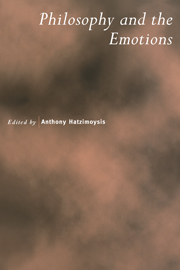Book contents
- Frontmatter
- Contents
- Preface
- Notes on Contributors
- I Emotions, Thoughts and Feelings: What is a ‘Cognitive Theory’ of the Emotions and Does it Neglect Affectivity?
- II The Emotions and their Philosophy of Mind
- III Basic Emotions, Complex Emotions, Machiavellian Emotions
- IV Emotion, Psychosemantics, and Embodied Appraisals
- V Emotions and the Problem of Other Minds
- VI Emotional Feelings and Intentionalism
- VII Emotions, Rationality, and Mind/Body
- VIII The significance of recalcitrant emotion (or, anti-quasijudgmentalism)
- IX The Logic of Emotions
- X Emotion and Desire in Self-Deception
- XI Emotion, Weakness of Will, and the Normative Conception of Agency
- XII Narrative and Perspective; Values and Appropriate Emotions
- XIII Passion and Politics
- XIV Don't Worry, Feel Guilty
- Index
IV - Emotion, Psychosemantics, and Embodied Appraisals
Published online by Cambridge University Press: 06 January 2010
- Frontmatter
- Contents
- Preface
- Notes on Contributors
- I Emotions, Thoughts and Feelings: What is a ‘Cognitive Theory’ of the Emotions and Does it Neglect Affectivity?
- II The Emotions and their Philosophy of Mind
- III Basic Emotions, Complex Emotions, Machiavellian Emotions
- IV Emotion, Psychosemantics, and Embodied Appraisals
- V Emotions and the Problem of Other Minds
- VI Emotional Feelings and Intentionalism
- VII Emotions, Rationality, and Mind/Body
- VIII The significance of recalcitrant emotion (or, anti-quasijudgmentalism)
- IX The Logic of Emotions
- X Emotion and Desire in Self-Deception
- XI Emotion, Weakness of Will, and the Normative Conception of Agency
- XII Narrative and Perspective; Values and Appropriate Emotions
- XIII Passion and Politics
- XIV Don't Worry, Feel Guilty
- Index
Summary
Two Theoretical Approaches to Emotion
There seem to be two kinds of emotion theorists in the world. Some work very hard to show that emotions are essentially cognitive states. Others resist this suggestion and insist that emotions are noncognitive. The debate has appeared in many forms in philosophy and psychology. It never seems to go away. The reason for this is simple. Emotions have properties that push in both directions, properties that make them seem quite smart and properties that make them seem quite dumb. They exemplify the base impulses of our animal nature while simultaneously branching out into the most human and humane reaches of our mental repertoires. Depending on where one looks, emotions can emerge as our simplest instincts or our subtlest achievements. This double nature makes emotions captivating, but also confounding. Researchers find themselves picking one side at the expense of the other, or packaging seemingly disparate components into unstable unions. I will defend a more integrative approach. For a more thorough treatment, see Prinz (forthcoming).
Noncognitive Theories
As I will use the terms, a cognitive theory of the emotions is a theory that maintains that all true emotions involve cognitions essentially. Noncognitive theories maintain that emotions do not necessarily involve cognitions. It is no easy matter to say what cognitions are. A failure to define this key term can easily lead to unproductive cross-talk. Despite that caveat, I will proceed without a definition. One can capture the difference between cognitive and noncognitive theories by considering some examples.
- Type
- Chapter
- Information
- Philosophy and the Emotions , pp. 69 - 86Publisher: Cambridge University PressPrint publication year: 2003
- 8
- Cited by



